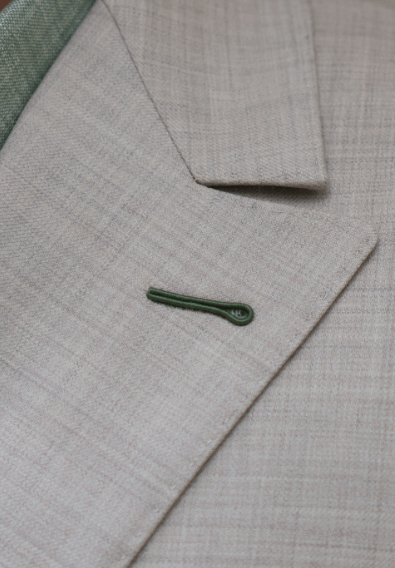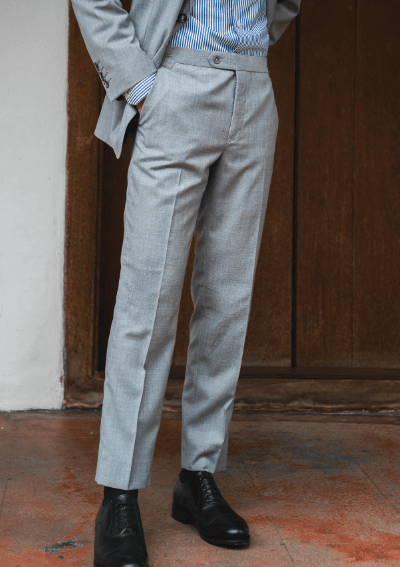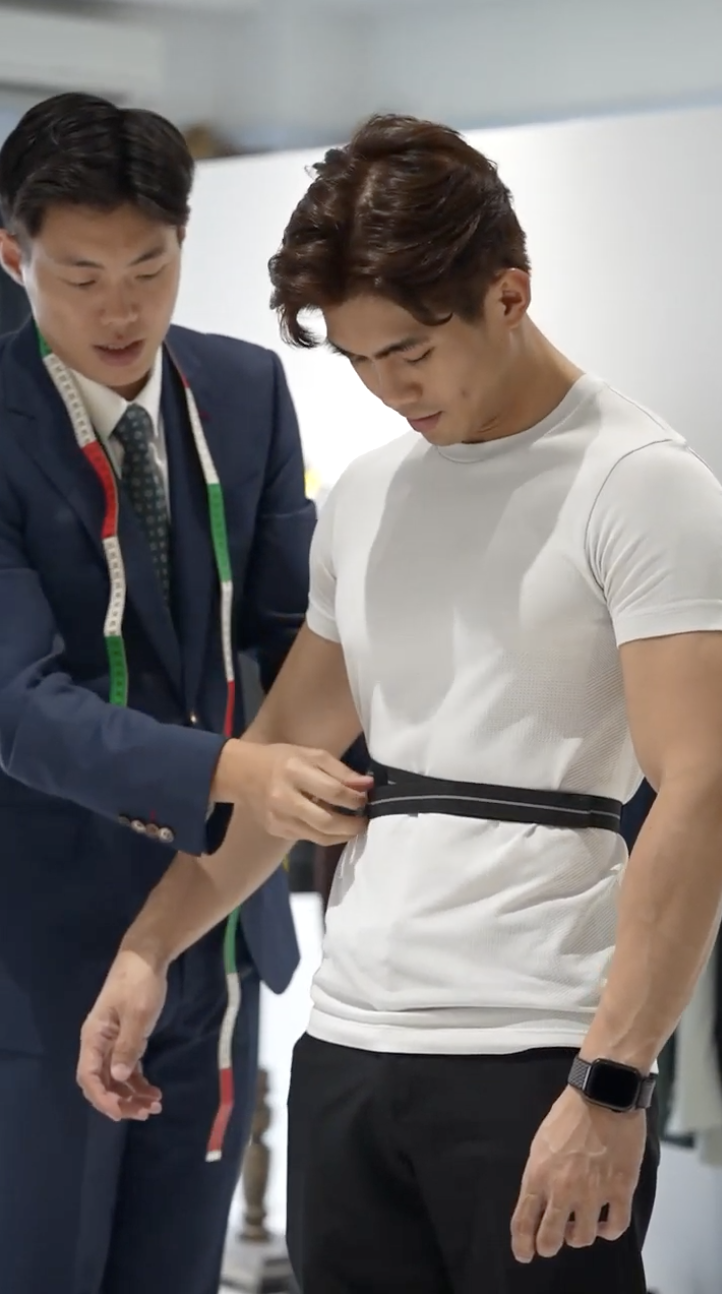Custom Suit Checklist: Lapels, Vents, Lining, Fit and Many More
- JJ Lai
- Oct 17
- 9 min read

The finest suits reveal their quality through exacting details that discerning gentlemen recognise immediately. Lapel construction, vent positioning, and lining selection represent fundamental decisions that define your garment’s character.
This comprehensive guide by Gentlemen’s Pursuit illuminates the essential elements that transform exceptional fabric into timeless elegance. With this, you can be sure every specification serves your form and function.
Jacket and Coat

The jacket is the cornerstone of any tailored suit. It sets the tone for your entire look, determines your silhouette, and communicates refinement. Every choice in construction and style contributes to how the jacket performs and how you feel wearing it.
Lapels
Lapels define the suit’s expression. They frame the chest and lead the eye toward the shoulders. The gorge height, the width of the blade, and the roll are measured to harmonise with your torso and the jacket’s purpose. A notch lapel works beautifully for business and is a staple on single-breasted suits, while a peak lapel has more drama, widening the shoulders and adding authority.
Options: Notch lapel, peak lapel, shawl lapel, wide lapel, narrow lapel, and more
Breasted Style
Single-breasted, double-breasted. This is the first choice that anchors your design. Single-breasted jackets are cut closer to the body and typically offer one to three buttons. Double-breasted pieces bring a strong stance and require precision in wrap and button alignment to lie smoothly when closed. A six-on-two double-breasted layout is a classic, while a four-on-one has a slightly more fashion-forward feel.
Options: Single-breasted two-button, single-breasted three-button, double-breasted six-on-two, double-breasted four-on-one, double-breasted six-on-one, and more
Buttons
The buttons are small but essential. Their placement dictates the visual centre of the jacket, and their material determines durability. Horn remains the classic choice, corozo provides a refined matte surface, and mother-of-pearl offers a subtle glow. Many clients choose four functional buttons on the sleeve for tradition, but three works well on a slimmer, more contemporary sleeve.
Options: Horn, corozo, mother-of-pearl, metal, covered buttons, and more
Vents
Movement starts here. Double vents keep the back clean when you sit, while single vents give a simpler finish. Vent height, shape, and angle are chosen to keep the lines uninterrupted as you walk. A ventless back creates a very clean line, most often used for formalwear such as tuxedos.
Options: Single vent, double vent, ventless, high vents, side vents, and more
Jacket Length and Cut
A jacket should divide your frame neatly, usually covering the seat and aligning with the curve of the hand. Some men prefer a slightly shorter skirt for a modern feel, others opt for a longer line for gravitas. The cut—slim, regular, or generous—should match how you carry yourself. A cropped cut pairs well with slimmer trousers, while a long line cut adds height and looks sharp over fuller trousers.
Options: Classic cut, slim cut, cropped length, long line cut, extended cut, and more
Waist Suppression
Here’s where the magic of shaping happens. A tailor will sculpt the waist using side seams and darts until the jacket follows the natural line of your torso. The result is an athletic silhouette that still allows comfort when buttoned. Strong suppression creates a bold V-shape, while minimal shaping is chosen for a relaxed, softly draping jacket.
Options: Natural waist, moderate suppression, strong suppression, flared skirt, minimal shaping, and more
Chest Canvas
Inside the jacket lies its structure. Full canvas gives the garment life and ensures it molds to you over time. Half canvas is a lighter option, still elegant but a touch less formal. Floating horsehair canvases are especially valued for the way they create a sculpted chest that softens naturally with wear.
Options: Full canvas, half canvas, floating canvas, horsehair canvas, fusible canvas, and more
Collar Style
The collar is quiet, but crucial. It must hug the neck without gap, keeping the jacket in place as you move. Even the felt undercollar can be a place for a discreet flash of personality. A Neapolitan collar with light construction gives a relaxed feel, while a wide notch collar creates a strong, modern line.
Options: Standard notch collar, wide notch collar, narrow collar, Neapolitan collar, contrasting undercollar, and more
Back Pleats or Darts
Darts slim the waist. Pleats, especially action pleats, open for ease of movement. Choosing between them is about balancing clean lines with comfort. Bi-swing pleats are particularly practical for sport coats or jackets worn while traveling.
Options: Side darts, centre darts, bi-swing pleats, inverted pleat, plain back, and more
Shoulder Structure
The shoulder sets the mood. Rope shoulders give military definition, spalla camicia is soft and casual, and a natural shoulder is quiet and understated. Padding is added or removed until the line is just right. Some men prefer a strong, English-inspired structured shoulder, while others opt for the soft Neapolitan shoulder for casual charm.
Options: Light padding, structured shoulder, rope shoulder, natural shoulder, spalla camicia, and more
Armhole Height and Mobility
A high armhole is not restrictive when cut well—it actually helps you move. Tailors measure shoulder slope, chest width, and sleeve pitch so the arm can lift without the jacket riding up. Forward-cut sleeves work well for those who spend time at a desk, reducing creasing at the elbow.
Options: High armhole, moderate armhole, low armhole, soft scye, forward-cut sleeve, and more
Cuffs and Sleeve Finish
Working buttonholes signal a custom job. Sleeve length should reveal a touch of shirt cuff and follow the natural angle of the arm. The finishing, from button stance to stitching, is where personality lives. Kissing buttons give a refined, European look, while stacked buttons look slightly sportier.
Options: Working cuffs, kissing buttons, stacked buttons, contrast stitching, gauntlet cuff, and more
Pick Stitching and Edge Finishing
Handmade pick stitching is subtle but unmistakable. It traces the lapel edge, hinting at craftsmanship without distracting from the suit. Edge finishing also decides how crisply the lapel rolls. AMF stitching offers a more uniform line, great for business suits, while hand pick stitching has a softer, artisanal charm.
Options: Machine edge, hand pick stitching, AMF stitching, edge welt, subtle pick stitch, and more
Fabric and Finish

Fabric is where your suit truly begins to speak. It decides the weight on your shoulders, the feel under your hand, and how the suit drapes with every step.
Fabric Type
In Singapore, the weather is warm, the humidity high, and indoor air-conditioning common—so your suit fabric matters. Wool is the classic go-to: breathable, wrinkle-resistant, and resilient. Cashmere adds luxury, silk-wool blends provide a subtle sheen and lightweight elegance, and linen or tropical wool blends keep you cool on humid streets. Flannel wool, meanwhile, creates a soft, sophisticated look for evening events or office environments with cooler AC.
Options: Worsted wool, flannel wool, mohair blend, cashmere, linen, and more
Pattern or Weave
Patterns carry personality. Twill, serge, and hopsack each fall differently, creating texture or crispness. When done well, the patterns match at every seam, showing the tailor’s skill. A bold windowpane can make a statement, while a subtle pinstripe elongates the frame.
Options: Solid, pinstripe, chalk stripe, windowpane, glen check, and more
Weight and Seasonality
Choose your cloth weight wisely. Lighter weights suit warm months, heavier ones hold shape and keep you insulated in colder environments. Midweights are the workhorses of a wardrobe. A tropical-weight wool around 220g is perfect for humid office days or outdoor events, while a 340g flannel is unbeatable when travelling for business to cooler destinations.
Options: Lightweight (220g), midweight (280g), heavy (340g), tropical weight, winter flannel, and more
Texture and Finish
A matte finish whispers and a polished finish shines. Milling, brushing, or pressing can make the same fabric look refined or casual. Touch it—that’s where you’ll feel the difference. High-twist finishes are excellent for travel, resisting wrinkles while keeping a sharp crease.
Options: Worsted finish, milled flannel, brushed, high-twist, polished finish, and more
Colour and Lining
Colour sets the mood. Navy and grey remain timeless, but lining is where many gents take a risk—a flash of burgundy, a patterned silk, or even a monogrammed surprise. Contrasting linings in jewel tones create drama when you take the jacket off.
Options: Navy, charcoal, mid-grey, brown, patterned lining, and more
Functional and Personal Details

This is where the suit becomes yours. Small decisions add charm, practicality, and sometimes a wink of individuality known only to you.
Hidden Pockets
A discreet ticket pocket is a nod to old-world tailoring. Interior pockets are measured to fit phones and cards without sagging. Watch pockets and hidden zip compartments are popular choices for men who travel frequently.
Options: Standard interior pocket, ticket pocket, watch pocket, coin pocket, pen pocket, and more
Monogram and Personal Embroidery
Embroidery adds a signature, visible only when you want it to be. A date under the collar, initials inside the lining. These can be subtle and meaningful. Crest embroidery is a striking touch for family or club affiliations.
Options: Script monogram, block monogram, date embroidery, crest embroidery, contrasting thread, and more
Buttonhole Thread Colour
Contrast buttonholes can be understated or bold. Silk thread creates a smooth finish, and a Milanese boutonnière offers elegance for special occasions. Some clients choose only the lapel buttonhole in contrast for a discreet hint of personality.
Options: Tonal buttonhole, contrast buttonhole, Milanese buttonhole, silk thread, hand-bound, and more
Extra Trousers or Spare Fabric
Ordering an extra pair of trousers doubles the life of the suit. A little-known tip is to ask for spare fabric to keep on hand for future repairs or alterations. Clients also often request an unfinished second trouser hem so they can choose cuff style later.
Options: Second pair of trousers, spare cloth swatch, unfinished hem, lined trousers, brace buttons, and more
Trousers and Bottoms

Trousers complete the suit’s silhouette and must complement the jacket’s line. Rise, waistband, and hem shape work together to achieve a clean, uninterrupted drape.
Rise
The rise controls where the waistband sits and how the jacket overlaps it. Higher rises lengthen the leg visually and help keep the shirt tucked. Extended rises are perfect for vintage-inspired suits and pair well with braces.
Options: High rise, mid rise, low rise, extended rise, natural rise, and more
Front Style
Flat fronts create a sleek appearance, while pleats offer comfort and drape. Inward-facing pleats are traditional, outward-facing pleats are more casual. Double pleats provide extra room for athletic builds and are often paired with cuffed hems.
Options: Flat front, single pleat, double pleat, reverse pleat, Hollywood top, and more
Waistband
The waistband must anchor the trousers comfortably. Curtain waistbands provide flexibility and help distribute stress evenly. Side adjusters eliminate the need for a belt for a cleaner look. Brace buttons can be added if you prefer suspenders, giving a very classic line.
Options: Belt loops, side adjusters, brace buttons, split waistband, extended tab closure, and more
Fly
Fly construction affects bulk and security. Button flies are hand-sewn and offer a classic approach, while zip flies are quick and practical. Hidden flies give an especially clean finish on formal trousers.
Options: Button fly, zip fly, hidden fly, extended tab fly, French bearer, and more
Hem Finish
Hem finish controls how the trouser leg rests over the shoe. Cuffs add weight and are traditional with pleated fronts, while plain hems create a sharp break line. A deep cuff of 2 inches adds personality and is excellent for taller men.
Options: Cuffed hem, plain hem, turn-up cuff, deep cuff, blind stitch hem, and more
Fit and Break
Break describes how the trouser front meets the shoe. Full break is more traditional, while no break gives a contemporary line. Proper taper ensures the trouser moves cleanly. A cropped hem with no break pairs well with loafers for a relaxed but polished look.
Options: Full break, half break, slight break, no break, cropped length, and more
Optional Pieces and Coordination

Additional pieces expand the versatility of your wardrobe. A three-piece suit or extra jacket gives you multiple ways to wear the same cloth.
Waistcoat or Vest
A waistcoat extends the visual line of the suit and keeps the shirt in place. It should sit close without pulling across the chest. A double-breasted waistcoat with a shawl lapel is especially striking at formal occasions.
Options: Single-breasted waistcoat, double-breasted waistcoat, notch lapel waistcoat, shawl lapel waistcoat, backless waistcoat, and more
Spare Jacket or Odd Trousers
Commissioning an extra jacket or odd trousers allows mix-and-match wear. This is particularly practical with patterned cloths or seasonal fabrics. Many choose an odd jacket with softer shoulders for weekend wear, leaving the main suit jacket more structured for business.
Options: Odd jacket, sports coat, odd trousers, dinner jacket, field jacket, and more
Fit and Tailoring

Final adjustments bring every measurement into harmony. The jacket and trousers must sit correctly on the body while remaining comfortable for daily wear.
Overall Fit
A well-fitted suit follows the body’s natural line without excess tension. Balance is checked with the jacket buttoned and arms relaxed. A sculpted fit can highlight the waist and chest, while a comfort fit prioritises ease for long wear.
Options: Slim fit, classic fit, relaxed fit, sculpted fit, comfort fit, and more
Balance and Proportion
Vertical and horizontal balance ensure the jacket does not tip forward or backward. Proportion determines lapel width, pocket placement, and skirt length relative to your frame. Long line proportions lengthen the torso visually, while short proportions emphasise the legs.
Options: Standard balance, adjusted front-back balance, long line proportion, short
proportion, custom proportion, and more
Ease of Movement
A suit should allow you to sit, walk, and extend your arms freely. Tailors adjust back pitch, sleeve head, and crotch depth to ensure range of motion. A sport cut ease is ideal for jackets worn during travel or active workdays.
Options: Relaxed ease, moderate ease, fitted ease, sport cut ease, travel suit ease, and more
Making It Yours at Gentlemen’s Pursuit
The finest custom suits emerge from clear communication and skilled execution. Our process transforms your vision into precise measurements and carefully selected details that enhance your body’s natural silhouette. Contact Gentlemen’s Pursuit to experience how collaborative tailoring produces suits that exceed expectations while honouring your individual style.



Comments